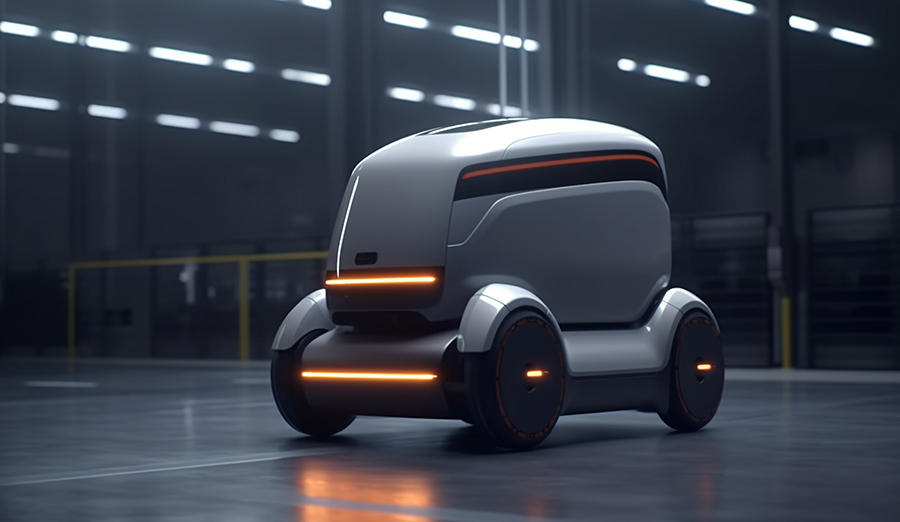
WIRELESS CHARGING IN THE NEWS
Under the wave of Industry 4.0, AGV/AMR carts, as key equipment for intelligent logistics and automated production, the efficiency and convenience of their charging methods have increasingly become the focus of industry attention. The emergence of magnetic coupling resonant wireless charging technology has brought about a new revolution in the energy supply of AGV/AMR vehicles.
The working principle of magnetic coupling resonant wireless charging is based on electromagnetic induction and resonance phenomena. The system is mainly composed of the transmitting end and the receiving end. The transmitting end converts electrical energy into high-frequency alternating current through the power supply. This high-frequency current flows in the transmitting coil, thereby generating an alternating magnetic field. When the coil at the receiving end is in this alternating magnetic field, according to the law of electromagnetic induction, an induced electromotive force will be generated, thereby achieving wireless transmission of electrical energy. Resonance, on the other hand, enables the transmitting coil and the receiving coil to operate at the same natural frequency. When they reach a resonant state, energy can be transferred efficiently between them, much like two tuning forks of the same frequency. The vibration of one will trigger a strong resonance in the other.
When designing a magnetic coupling resonant wireless charging system, several key parameters cannot be ignored. First is the resonant frequency, which directly affects the efficiency and distance of energy transmission. An appropriate resonant frequency can reduce energy loss during transmission and improve charging efficiency. Generally speaking, a higher resonant frequency can achieve a longer transmission distance, but it also increases the risk of electromagnetic interference. Secondly, there is the quality factor of the coil, which reflects the ratio of the energy stored to the energy consumed by the coil. The higher the quality factor, the more energy the coil can store during resonance, and the higher the energy transmission efficiency will be. In addition, the coupling coefficient between coils is also of vital importance. It indicates the tightness of the magnetic coupling between two coils. The larger the coupling coefficient, the more efficient the energy transmission.
In terms of design key points, the structural design of the coil is the core. Different application scenarios require coils of different shapes and sizes, such as circular and square ones. A reasonable coil layout can enhance the coupling effect of the magnetic field and improve the efficiency of energy transmission. At the same time, appropriate materials should be used to make the coil to reduce resistance loss. In addition, it is necessary to design an efficient resonant compensation circuit to ensure that the transmitting and receiving ends are always in a resonant state, thereby enhancing the stability and reliability of the system.
Let's take a look at the application effect of magnetic coupling resonant wireless charging technology in AGV/AMR carts through a practical case below. A large electronic manufacturing enterprise has introduced AGV carts equipped with magnetic coupling resonant wireless charging systems for material handling on the production line. Before the application of this technology, AGV carts adopted the traditional contact charging method, which required manual intervention, had a long charging time, and frequent plugging and unplugging operations were prone to damage the charging interface. After adopting wireless charging technology, AGV carts can automatically charge during driving without the need for manual intervention. The charging efficiency has been significantly enhanced, with the average charging time reduced by more than 30%. At the same time, due to the reduced wear of contact charging, the maintenance cost of the equipment has been reduced by 25%.
Of course, this technology is not perfect either. Its advantages are obvious. The wireless charging method avoids the mechanical wear and electric spark problems of contact charging, improving the safety and reliability of the system. Meanwhile, the charging process does not require manual intervention, achieving automation and enhancing production efficiency. However, there are also drawbacks. The initial investment cost of the magnetic coupling resonant wireless charging system is relatively high, including the procurement and installation costs of both the transmitting and receiving end equipment. In addition, this technology generates a certain amount of electromagnetic radiation during the energy transmission process, and corresponding shielding measures need to be taken to ensure safety.
Magnetic coupling resonant wireless charging technology has brought new opportunities for the development of AGV/AMR carts. With the continuous advancement of technology and the gradual reduction of costs, it is expected to be more widely applied in the fields of intelligent logistics and automated production.







